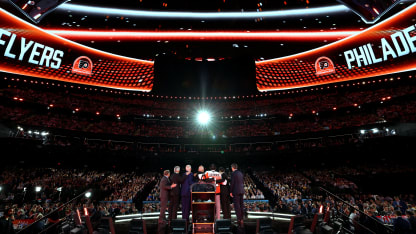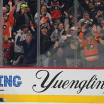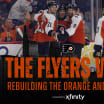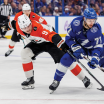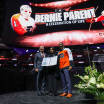Different NHL organizations have slightly different ways for assessing and rating players for the first round of the NHL Draft. Some heavily prioritize character and two-way play a little higher while others primarily want whichever player has the highest offensive upside.
Some organizations care more than others about which position someone plays. Centers and defenseman, in many cases, receive preference over similarly talented natural wingers. Meanwhile, some organizations simply will not draft a goaltender in Round One even if the club owns more than one pick.
Likewise, different teams weigh certain potential drawbacks a little more heavily than others. This could include a prospect's size/frame, concerns over skating flaws, emotional or physical maturity, or an injury concern. Meanwhile, some teams place a little more stock than others in the annual NHL Scouting Combine. For the Flyers and other teams, the Combine is used to fine-tune final internal rankings but it does not radically alter the pre-Combine outlook.
Within those parameters, every NHL organization will say it wants "the best available player" in Round One when their turn(s) to select come up. But what exactly does that mean to the Flyers?
"We look at everything," Flyers vice president and assistant general manager Brent Flahr said.
"We don't want to take a center just to take one, if there's a winger or defenseman we think will be a better player in the big picture. We've taken some wingers in the first round [such as Tyson Foerster and Matvei Michkov]. We've taken defensemen [like Cam York and Oliver Bonk]. We go by our own rankings overall. Maybe later in the Draft, you look for depth at a position or a couple of specific traits. But the first round for us is about the best player."
The Flyers hold three picks in the 2025 Entry Draft: the 6th, the 22nd (originally belonging to the Colorado Avalanche) and the 31st pick (Edmonton). The Flyers also hold four picks in the second round. Overall, Philly currently owns seven picks in the top 48 of this year's Draft.
"We feel like we are in a good position with our picks," Flahr said. "We can do a lot of different things. We'll have options."
Specific to the sixth overall pick, Flyers President of Hockey Operations Keith Jones said he thinks it's unlikely the club will try to trade the pick as part of an effort to move up into the top two to four.
"You never know what can happen, but I probably don't see us moving up. In this year's Draft, there's the defenseman, [Matthew] Schaeffer who is probably going to be picked first. The Islanders aren't going to trade that pick, realistically. After that, there's several players we like about the same. We're pretty confident we'll be able to get one of them at number six. So there probably won't be a need to move up."
Pundits often bandy names such as Michael Misa (center), Porter Martone (wing), Anton Frondell (center), Caleb Desnoyers (center), James Hagens (center), Brady Martin (center/wing), Jake O'Brien (center), Roger McQueen (center), Viktor Eklund (right wing) and Radim Mrtka (defenseman) as candidates for top five to top 10 selections. Other names in some top 10 to top 12 lists include Jackson Smith (defenseman), Kashawn Aitcheson (defenseman), Carter Bear (left wing), and Logan Hensler (defenseman).
Meanwhile, there is always a chance that a club with a top-five could go "off the board" (AKA deviate significantly from the pundit consensus) and take a late-rising prospect or someone they've liked from the start but pundits rank lower.
Sault Ste. Marie Greyhounds center Brady Martin is now in many publicly available lists as a potential top-five to top-10 pick: so much so that he wouldn't be considered an off the board name if he's picked in that rank. Last year, the Anaheim Ducks took right winger Beckett Sennecke third overall.
That's the unpredictability of the NHL Draft itself in a nutshell. There's always the chance of a surprise or two that shakes up the selection order. Even more unpredictable: which teenage players will take developmental leaps, stagnate or deal with post-Draft injuries that alter their trajectory.
In upcoming articles, we'll look at the most commonly mentioned players at various different positions. Keep in mind that many junior/collegiate centers end up as wingers in the pro level. The opposite also happens but much less frequently.

